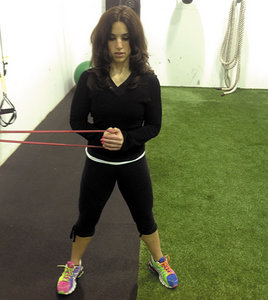16
2013
3 unconventional ab exercises
When people want to work the abs usually sit-up, side bends and crunches come to mind. However based largely on the works of Dr. Stuart McGill, one the leading expects of low back pain, these exercises may place undue stress on the low back because of the excessive bending of the low back. In fact taking a closer look at the anatomy of the core itself, the primary function of the abs is to resistant movement and maintain proper posture and alignment.
Try these exercises to not only protect your low back, but also challenge the core and get the heart rate up with total body exercises that utilize the core in a more” functional” way.
Single arm weighted carry:
 Why it works: Usually people think this is as only a strongman contest exercise to test the grip, but I think of this exercise as a walking side plank. Anytime you hold a heavy load on one side of the body and not the other, it requires the core muscles to offset the unbalanced load. This workout is a fat loss and core conditioning exercise all rolled into one.
Why it works: Usually people think this is as only a strongman contest exercise to test the grip, but I think of this exercise as a walking side plank. Anytime you hold a heavy load on one side of the body and not the other, it requires the core muscles to offset the unbalanced load. This workout is a fat loss and core conditioning exercise all rolled into one.
Also, because this is an intense full body exercise that jacks up your heart rate, not only will you burn more calories while your exercising, but also a post-workout metabolic boost that lasts up to 24-72 hours. That means you’re burning more calories even while you’re away from the gym.
How to do it. To do the exercise correctly, maintain good posture with a straight back and chest up. You’ll want to use relatively light weights when starting, until you’re confident that your body positioning is correct. Grab a dumbbell or kettlebell with palms facing your thighs walk forward at a moderate pace, keeping your core braced and head high the entire time. Start with 3 sets of 15 to 20 steps (about 30 to 45 feet), resting 60 seconds between sets. Increase the distance or use a heavier weight to progress.
Push-ups:
Why it works: Just holding the push up position is very similar to a plank hold. And although there is little movement of the core, the stability required is like a game of tug-of-war. The core is working against gravity and both are working hard, but one is moving. This requires a tremendous amount of energy, although it may not look like it. This is why proper execution is a must.
If your hips sag at any point during the exercise or you butt is too high, your form has broken. When this happens, consider that your last repetition and end the set.
How to do it: Place hands on a box, bench, or step slightly wider than and in line with shoulders. Slowly lower body until your chest nearly touches the bench. Pause at the bottom and then push back up to the starting position as quickly as possible
Pallof Press:
 Why it works: Is a great anti-rotation exercise. Once again if you actually look at the anatomy, you’ll notice that our core is more of a cross-hatched web and its main function is to resisting trunk extension, pelvic tilt, and transmission of hoop stress (rotary or anti-rotation motion).
Why it works: Is a great anti-rotation exercise. Once again if you actually look at the anatomy, you’ll notice that our core is more of a cross-hatched web and its main function is to resisting trunk extension, pelvic tilt, and transmission of hoop stress (rotary or anti-rotation motion).
How to do it: Use a resistance band, or a cable pulley at about belly button height, and warp it around a stationary object. Focus on standing tall with slightly bent knees and chest up. Start will your hands by your belly button and then extend your arms. As you extend your arms out and increase the lever arm the more you have to resist the pull of the band wanting to twist you, don’t allow it and bring your arms back to the starting position.
Standing farther away will make the exercise more difficult. Also you can make it harder by having your feet closer together to reduce your base of support. This is a good beginner to advanced exercise.
As always consult your doctor prior to starting any exercise program and if you are unsure how to properly preform any exercise, seek the advice of a trained fitness professional.
 An article by
An article by 